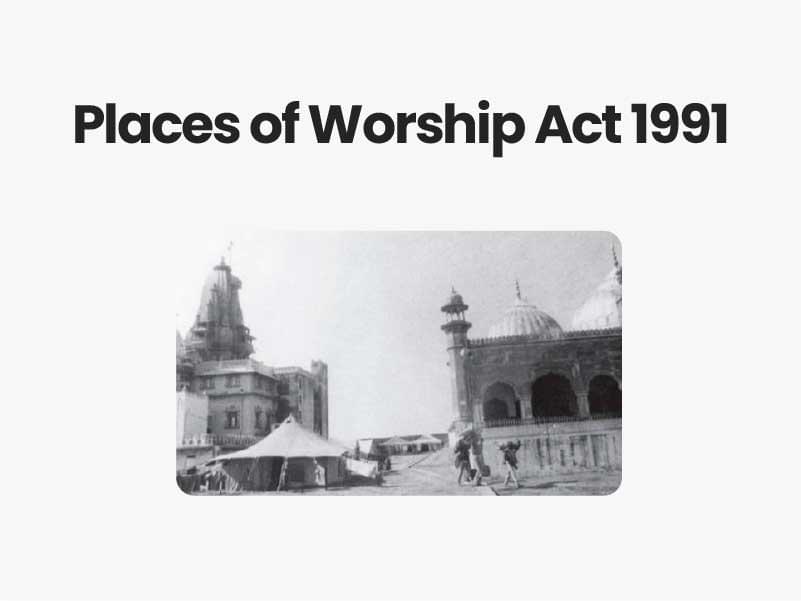Companion@360 → 7 Month programme to sharpen your writing skills → REGISTER NOW

Places of Worship Act 1991
The Supreme Court asked the Centre to respond to a plea challenging the Places of Worship (Special Provisions) Act, 1991. In agreeing to examine the law, the court has opened the doors for litigation in various places of worship across the country including Mathura and Varanasi.
What is the law about?
- Passed in 1991 by the P V Narasimha Rao-led Congress government, the law seeks to maintain the “religious character” of places of worship as it was in 1947 — except in the case of Ram Janmabhoomi-Babri Masjid dispute, which was already in court.
- The law was brought in at the peak of the Ram Mandir movement, exactly a year before the demolition of the Babri Masjid.
- Introducing the law, then Home Minister S B Chavan said in Parliament that it was adopted to curb communal tension.
What are its provisions?
- The clause declaring the objective of the law describes it as “an Act to prohibit conversion of any place of worship and to provide for the maintenance of the religious character of any place of worship as it existed on the 15th day of August, 1947, and for matters connected therewith or incidental thereto”.
- Sections 3 and 4 of the Act declare that the religious character of a place of worship shall continue to be the same as it was on August 15, 1947 and that no person shall convert any place of worship of any religious denomination into one of a different denomination or section.
- Section 4(2) says that all suits, appeals or other proceedings regarding converting the character of a place of worship, that were pending on August 15, 1947, will stand abated when the Act commences and no fresh proceedings can be filed.
- However, legal proceedings can be initiated with respect to the conversion of the religious character of any place of worship after the commencement of the Act if the change of status took place after the cut-off date of August 15, 1947.
What does it say about Ayodhya, and what else is exempted?
- Section 5 says: “Act not to apply to Ram Janma Bhumi Babri Masjid. Nothing contained in this Act shall apply to the place or place of worship commonly known as Ram Janma Bhumi-Babri Masjid situated in Ayodhya in the State of Uttar Pradesh and to any suit, appeal or other proceeding relating to the said place or place of worship.”
- Besides the Ayodhya dispute, the Act also exempted:
any place of worship that is an ancient and historical monument or an archaeological site, or is covered by the Ancient Monuments and Archaeological Sites and Remains Act, 1958; a suit that has been finally settled or disposed of; any dispute that has been settled by the parties or conversion of any place that took place by acquiescence before the Act commenced.
Read NSDL
What has the Supreme Court said about the Act?
- In the 2019 Ayodhya verdict, the Constitution Bench led by former Chief Justice of India Ranjan Gogoi referred to the law and said it manifests the secular values of the Constitution and strictly prohibits retrogression.
- “In providing a guarantee for the preservation of the religious character of places of public worship as they existed on 15 August 1947 and against the conversion of places of public worship, Parliament determined that independence from colonial rule furnishes a constitutional basis for healing the injustices of the past by providing the confidence to every religious community that their places of worship will be preserved and that their character will not be altered.
- The law addresses itself to the State as much as to every citizen of the nation. Its norms bind those who govern the affairs of the nation at every level.
- Those norms implement the Fundamental Duties under Article 51A and are hence positive mandates to every citizen as well.
- The State, has by enacting the law, enforced a constitutional commitment and operationalized its constitutional obligations to uphold the equality of all religions and secularism which is a part of the basic structure of the Constitution,” the court said.
Why is the law under challenge?
- Delhi advocate Ashwini Upadhyaya has challenged the law on the ground that violates secularism.
- He has also argued that the cut-off date of August 15, 1947 is “arbitrary, irrational and retrospective” and prohibits Hindus, Jains, Buddhists, and Sikhs from approaching courts to “re-claim” their places of worship which were “invaded” and “encroached” upon by “fundamentalist barbaric invaders”.
- The BJP had opposed the law even when it was introduced, arguing that the Centre has no power to legislate on “pilgrimages” or “burial grounds” which is under the state list. However, the government had said it could make use of its residuary power under Entry 97 of the Union List to enact this law.
- Entry 97 confers residuary powers to the Centre to legislate on subjects that are not enumerated in any of the three lists.
- Another criticism against the law is that the cut-off is the date of Independence, which means that status quo determined by a colonial power is considered final.
Source: The Indian Express
